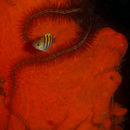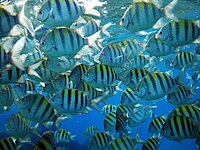Diagnostic Description
provided by CoralReefFish
Diagnosis: Damselfishes with 13 dorsal-fin spines indicate Abudefduf as well as the deep-water Chromis enchrysura, C. insolata, and C. scotti. Abudefduf saxatilis have a mode of 13 dorsal-fin soft rays and 12 anal-fin soft rays (D-XIII,13 A-II,11-12 Pect-18-19). A. taurus have fewer median-fin soft rays, with a mode of 12 dorsal-fin soft rays and 10 anal-fin soft rays (D-XIII,12 A-II,10 Pect-18-19). The Chromis species have modes of 12/11 or 12/12. (ML)
- license
- cc-by-3.0
- copyright
- www.coralreeffish.com by Benjamin Victor
Diagnostic Description
provided by Fishbase
Greenish yellow above, shading to white below, with 5 prominent vertical black bars that narrow toward belly (Ref. 26938). A faint sixth bar may be present posteriorly on caudal peduncle; a black spot at upper base of pectoral fin. The adult male becomes dark bluish, the black bars thus less conspicuous on the body (Ref. 13442).
- Recorder
- Grace Tolentino Pablico
Life Cycle
provided by Fishbase
Oviparous, distinct pairing during breeding (Ref. 205). Eggs are demersal and adhere to the substrate (Ref. 205). Males guard and aerate the eggs (Ref. 205).
Morphology
provided by Fishbase
Dorsal spines (total): 13; Dorsal soft rays (total): 12 - 13; Analspines: 2; Analsoft rays: 10 - 12
- Recorder
- Grace Tolentino Pablico
Trophic Strategy
provided by Fishbase
Inhabits inshore and offshore coral or rocky reefs (Ref. 7247). Juveniles are common in tide pools while adults found over shallow reef tops. Adults frequently form large feeding aggregations of up to several hundred individuals. It feeds primarily as a browsing herbivore (Ref. 275). Food items include algae, small crustaceans and fish, and various invertebrate larvae (Refs. 3139, 127989). Feeds on spinner dolphinsâ feces and vomits at Fernando de Noronha Archipelago, southeast Atlantic. The offal feeding may be regarded as a simple behavioral shift from plankton feeding to drifting offal picking. Also, juveniles hold cleaning stations together with the doctorfish (Acanthurus chirurgus) and the blue tang (Acanthurus coeruleus) and graze algae as well as pick molted skin and parasites from green turtles (Chelonia mydas ). This behavior is preceded by a characteristic inspection usually followed by feeding nips on the turtlesâ skin (head, limbs, and tail), as well as on the carapace. The most inspected and cleaned body parts are the flippers (Ref. 48727, 51385). Littoral species. Forms small to medium groups (Ref. 127989).
Biology
provided by Fishbase
Juveniles are common in tide pools while adults are found over shallow reef tops. Adults frequently form large feeding aggregations of up to several hundred individuals. Food items include algae, small crustaceans and fish, and various invertebrate larvae (Ref. 3139). At Fernando de Noronha Archipelago, this species feeds on spinner dolphinsâ feces and vomits. The offal feeding may be regarded as a simple behavioral shift from plankton feeding to drifting offal picking. Also, juveniles may hold cleaning stations together with the doctorfish (Acanthurus chirurgus) and the blue tang (Acanthurus coeruleus) and graze algae as well as pick molted skin and parasites from green turtles (Chelonia mydas ). This behavior is preceded by a characteristic inspection usually followed by feeding nips on the turtlesâ skin (head, limbs, and tail), as well as on the carapace. The most inspected and cleaned body parts are the flippers (Ref. 48727, 51385). Adult males adopt a bluish ground color when guarding eggs. Oviparous, distinct pairing during breeding (Ref. 205). Eggs are demersal and adhere to the substrate (Ref. 205). Attracted to divers who feed fish. Marketed fresh (Ref. 3139). Has been reared in captivity (Ref. 35420).
Importance
provided by Fishbase
fisheries: minor commercial; aquarium: commercial; price category: unknown; price reliability:
Sergeant major (fish)
provided by wikipedia EN
The sergeant major or píntano (Abudefduf saxatilis) is a species of damselfish. It grows to a maximum length of about 22.9 centimetres (9.0 in).[2]
Distribution and habitat
Abudefduf saxatilis is found in the Atlantic Ocean.[2] Populations in the western part of the Atlantic Ocean are found from the north eastern coast of the United States south to the Gulf of Mexico, the Bahamas, islands around the Caribbean Sea, the eastern coast of Central and South America all the way to Uruguay.[2] In the eastern Atlantic Ocean, they are found from Portugal, Azores, the Canary Islands, Cape Verde, and western Africa.[2] Its distribution remains unclear in the Mediterranean Sea due to possible confusion with Abudefduf vaigiensis and Abudefduf troschelii.[3] Juveniles are common in tide pools while adults are found over coral reefs.[2] Sergeant majors are found at depths of 0 to 40 metres (0 to 131 ft).[2]
Description
Adults can grow up to 22.9 centimetres (9.0 in) at maximum length.[2] Normally, they would grow up to 15 centimetres (5.9 in).[2] The largest recorded specimen weighed had a weight of up to 200 grams (7.1 oz).[2] Abudefduf saxatilis has 13 dorsal spines, 12 to 13 dorsal soft rays, 2 anal spines, and 10 to 12 anal soft rays.[2] This fish is white with a yellow top. It has 5 vertical stripes which are black. A faint sixth stripe might be present on the caudal peduncle.[2] Adult males have a more bluish coloration and its stripes are less visible.[2] There is a dark spot around its pectoral fin.
Ecology
Diet
This fish feeds upon the larvae of invertebrates, zooplankton, smaller fish, crustaceans, and various species of algae.[2] It is also known to feed on the waste and vomit of spinner dolphins.[2]
Behavior
Individuals of this species form shoals of about several hundred individuals.[2] Sometimes, they get cleaned of parasites by fish species such as gobies in the genus Gobiosoma, Bodianus rufus, Elacatinus figaro, and Thalassoma noronhanum.[2] Sergeant majors also clean green sea turtles along with Acanthurus chirurgus and Acanthurus coeruleus.[2]
Predators
Predators of this fish include Plectropomus leopardus, Thalassoma bifasciatum, Cephalopholis cruentata, Epinephelus striatus, Mycteroperca venenosa, and Rachycentron canadum.[2]
In the aquarium
They are found in the aquarium trade but are regarded as difficult to breed.[4]
Reproduction
The sergeant major is an oviparous species in which the males create nests on rocks, reef outcrops, shipwrecks, and pilings where the females lay their egg masses.[5] The males actively chase the females in courtship before the female releases approximately 200,000 ref, ovoid eggs which are attached to the substrate by a filament; the eggs turn greenish after a few days and are guarded by the male. As he guards the eggs the male becomes bluish in colour, guarding them for about a week.[6]
Etymology
Sergeant majors earn their name from their brightly striped sides, known as bars, which are reminiscent of the insignia of a military sergeant major.[6]
References

- license
- cc-by-sa-3.0
- copyright
- Wikipedia authors and editors
Sergeant major (fish): Brief Summary
provided by wikipedia EN
The sergeant major or píntano (Abudefduf saxatilis) is a species of damselfish. It grows to a maximum length of about 22.9 centimetres (9.0 in).
- license
- cc-by-sa-3.0
- copyright
- Wikipedia authors and editors
Description
provided by World Register of Marine Species
Usually found in shallow waters to around 15 meters, juveniles are common in tide pools while adults school over shallow reeftops. Adults frequently form large feeding aggregations of up to several hundred individuals. Food items include algae, small crustaceans and fish, and various invertebrate larvae. Adult males adopt a bluish ground colour when guarding eggs. Attracted to divers who feed fish. Generally common (Ref. 9710).
Froese, R. & D. Pauly (Editors). (2023). FishBase. World Wide Web electronic publication. version (02/2023).
- license
- cc-by-4.0
- copyright
- WoRMS Editorial Board
Diet
provided by World Register of Marine Species
Food items include algae, small crustaceans and fish, and various invertebrate larvae
North-West Atlantic Ocean species (NWARMS)
- license
- cc-by-4.0
- copyright
- WoRMS Editorial Board
Distribution
provided by World Register of Marine Species
Atlantic Ocean: 40.9°N to Uruguay in the western Atlantic, abundant on Caribbean reefs; around islands of the mid-Atlantic, Cape Verde, and along the tropical coast of western Africa south to Angola
North-West Atlantic Ocean species (NWARMS)
- license
- cc-by-4.0
- copyright
- WoRMS Editorial Board
Habitat
provided by World Register of Marine Species
nektonic
North-West Atlantic Ocean species (NWARMS)
- license
- cc-by-4.0
- copyright
- WoRMS Editorial Board
Habitat
provided by World Register of Marine Species
Adults frequently form large feeding aggregations of up to several hundred individuals.
North-West Atlantic Ocean species (NWARMS)
- license
- cc-by-4.0
- copyright
- WoRMS Editorial Board


